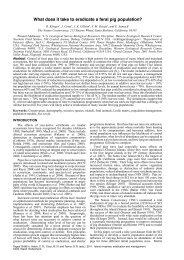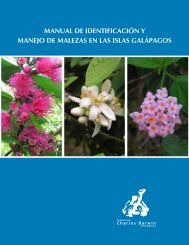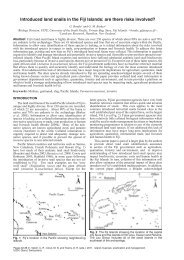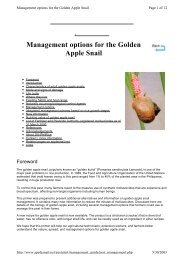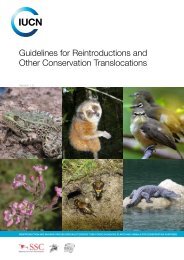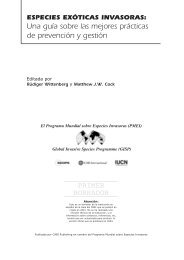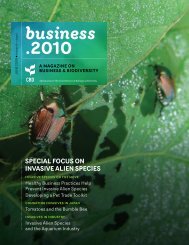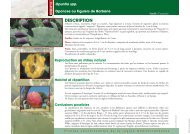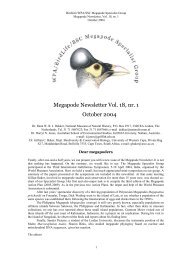Aliens - ISSG
Aliens - ISSG
Aliens - ISSG
You also want an ePaper? Increase the reach of your titles
YUMPU automatically turns print PDFs into web optimized ePapers that Google loves.
As has been demonstrated in our previous experiences,<br />
the active role of the community to help control<br />
the spread of an invasion is important. For this<br />
reason, Detection and Early Warning Systems have<br />
been provided for citizens to voluntarily cooperate<br />
in the capture of snakes and contribute to the overall<br />
success of the eradication process. This mechanism<br />
is in place for prevention and early action,<br />
based on information provided by community<br />
members on a voluntary basis through the website:<br />
http://www.lifelampropeltis.es/index.php/colabora<br />
or by directly contacting local government authorities.<br />
Finally, it is necessary to provide the tools for the<br />
prompt and continuous evaluation of the effectiveness<br />
and viability of control actions. In our case,<br />
such evaluation is very difficult due to the behaviour<br />
and biological characteristics of the California<br />
kingsnake. The Life+ Project has proposed molecular<br />
genetics techniques, specifically those based on<br />
the use of microsatellite markers, as an effective research<br />
tool to establish the effective size of natural<br />
populations and their genetic variability. Periodic<br />
analysis would be conducted in order to check if the<br />
populations have decreased and if the control measures<br />
have been successful.<br />
Conclusions<br />
Introduced into the wild by the accidental or deliberate<br />
release of individuals bred in captivity, the California<br />
kingsnake has settled in two areas in the<br />
Northwest and east of Gran Canaria. Both areas<br />
present different environmental characteristics and<br />
differences on diet, size, color pattern and sex rate<br />
of snakes, depending on their location.<br />
The data obtained until 2001 showed that the California<br />
kingsnake has a high ability to adapt and acclimatize,<br />
so the spread over the island is likely,<br />
which could pose a serious risk to critically endangered<br />
species. Also, the increased numbers will quite<br />
possibly impact the local reptilian population to the<br />
point where we see their total disappearance, especially<br />
in the areas with a higher population density<br />
of snakes.<br />
It is possible to reduce the density and the abundance<br />
of the California kingsnake by visual searching<br />
and hand capture. However, if the most<br />
favourable environmental conditions are determined,<br />
the task of capturing will be better. Other<br />
measures, such as the improvement of the traps and<br />
the use of trained dogs to detect snakes may increase<br />
the number of captures. In addition, the new regulation<br />
on exotic invasive species might reduce the<br />
risk of new introductions to the wild.<br />
We expect to reduce the populations of California<br />
kingsnake and its gradual eradication throughout the<br />
Life+ Lampropeltis project. It is expected that we<br />
reduce the distribution area up to 50% in the northwest<br />
of the island and the containment of the population<br />
in the east of the island, stopping further migration<br />
of the species.<br />
Acknowledgements<br />
We would specially like to thank Rafael Riera for<br />
his support since the beginning of the control programme<br />
and to all the people that have participated<br />
in it: the members of the fieldwork teams (José<br />
Miguel Sánchez, Alejandro Ramírez, Jorge Fernando<br />
Saavedra, Francisco Alarcón, Airam Eiroa, Juan<br />
Sánchez, Aitor Ojeda, Francisco Vera, Natanael<br />
Martín, Purificación Ventura, Antonio Alemán, Antonia<br />
Mª Lorenzo, José Luis Peña, Ivan Socorro,<br />
Ivan Sánchez, Anibal Peña, Alejandro Falcón y Yeray<br />
Bolaños), José Bergadá, Jim Pether, Carlos<br />
Canella and the inhabitants from La Solana and San<br />
Roque (Telde-Valsequillo). We are grateful to Cabildo<br />
de Gran Canaria, Dirección General de Protección<br />
de la Naturaleza and the European Union to<br />
support the Life+ Lampropeltis project.<br />
Additional information<br />
The LIFE+ Lampropeltis project http://www.lifelampropeltis.com<br />
References<br />
Álvarez C., Mateo JA, Oliver J and Mayol J (2010)<br />
Los ofidios ibéricos de introducción reciente<br />
en las Islas Baleares. Boletín de la Asociación<br />
Herpetológica Española 21:126-131<br />
Arechavaleta, M., Rodríguez S, Zurita N and García<br />
A (coord.) (2010) Lista de especies silvestres<br />
de Canarias. Hongos, plantas y animales<br />
terrestres 2009. Gobierno de Canarias 579 pp<br />
Cabrera-Pérez MA (2009) Programa de Control de<br />
la serpiente real de California en Gran Canaria<br />
(2008-2009). In: XVI Jornadas Forestales<br />
de Gran Canaria. Cabildo de Gran Canaria<br />
COP 8 Decisions Eighth Meeting of the Conference<br />
of the Parties to the Convention on Biological<br />
Diversity. Curitiba, Brazil. 20-31. March<br />
2006<br />
<strong>Aliens</strong> 27



